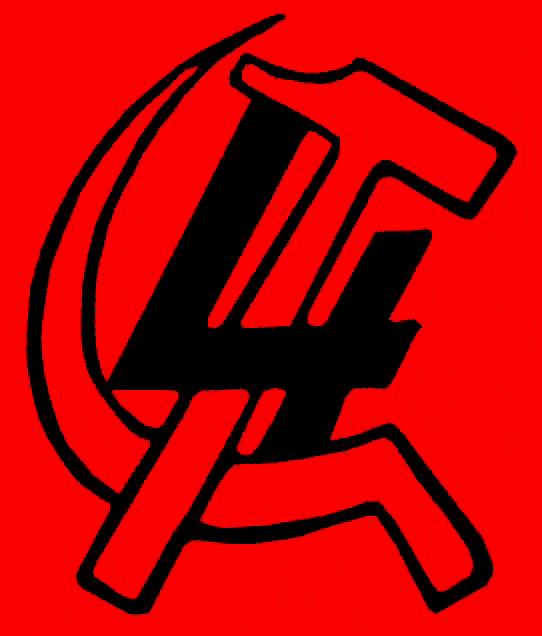
June 2005
Bolivia Explodes in Sharp Class Battle
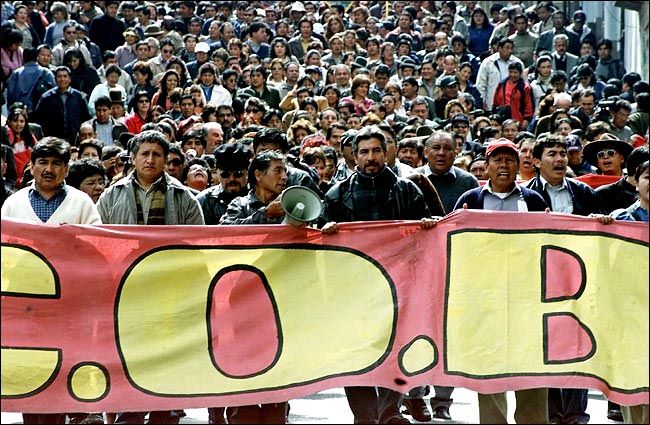
Bolivian
workers of COB union federation march in La Paz, May 17, protesting
approval by Congress
of gas and oil law guaranteeing profits for foreign energy companies
and demanding nationalization.
(Photo:
José Quintana/Reuters)
- Form Workers, Peasants and Soldiers Councils!
- Build the Nucleus of a Genuine Trotskyist Bolshevik Party!
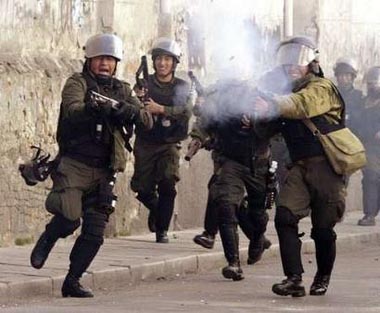 JUNE
1 – After three weeks of
massive mobilizations, tens of thousands of workers and peasants
besieged
Bolivia’s central government plaza yesterday. Throughout the day,
miners
exploded dynamite and riot cops fired tear gas as the demonstrators
fought to
break through police lines to seize the center of La Paz and shut down
the
rightist-dominated Bolivian Congress. Up to 50,000 participated in the
largest
and fiercest protests since the “gas war” of October 2003. Government
spokesmen
threatened repression against labor leaders. The class battle is coming
to a head,
as the choice is posed: advance toward a revolutionary outcome or face
defeat
at the hands of the bourgeoisie, whether in “democratic” guise or
through naked
military force.
JUNE
1 – After three weeks of
massive mobilizations, tens of thousands of workers and peasants
besieged
Bolivia’s central government plaza yesterday. Throughout the day,
miners
exploded dynamite and riot cops fired tear gas as the demonstrators
fought to
break through police lines to seize the center of La Paz and shut down
the
rightist-dominated Bolivian Congress. Up to 50,000 participated in the
largest
and fiercest protests since the “gas war” of October 2003. Government
spokesmen
threatened repression against labor leaders. The class battle is coming
to a head,
as the choice is posed: advance toward a revolutionary outcome or face
defeat
at the hands of the bourgeoisie, whether in “democratic” guise or
through naked
military force.For
the last several days, thousands of slum dwellers poured down into the
capital
from El Alto, the huge impoverished city on the heights above La Paz.
Labor and
peasant groups are blocking roads and highways. In addition to the
indefinite
work stoppage in El Alto, already in its second week, unlimited strikes
have
been called in key cities, including the mining centers of Oruro and
Potosí.
Tin miners have taken their place at the head of protests demanding
nationalization of gas and oil. The slogan “Obreros
al poder” (workers to power) is chanted by miners, teachers and
other sectors,
as working people increasingly talk of revolution. Yesterday, the
leader of the Central
Obrera Boliviana (COB – Bolivian Labor Federation) declared that if
Congress
does not immediately pass a nationalization law, “we are going to burn
it
down at any moment.”
The
protests also oppose rightist demands for “autonomy” of the richest,
“whitest”
departments (provinces) of this predominantly Indian country. Some
leaders of
the peasant movement are demanding that a “constituent assembly” be
called,
which in reality would be a parliamentary escape valve to defuse the
mass
unrest. These self-proclaimed “moderates” want more royalties from the
foreign-owned energy companies, as their ranks are being won over to
the demand
for nationalization. Recalling the army massacre of over 100 protesters
two
years ago, demonstrators chant: “Yesterday, bullets. Today, hunger. The
solution: revolution.” Yet reformist union tops are seeking to use the
mass
radicalization to engineer a “civilian-military” regime, “like Hugo
Chávez” in
Venezuela.
The desperate need of the hour is for
genuinely revolutionary leadership. The splits in the ruling class and divisions
among
the protesters have produced a temporary stand-off. But this cannot
last. Meanwhile sinister
counterrevolutionary forces are
gathering. Graffiti have appeared on the walls of La Paz with slogans
like, “Be
a patriot, kill a unionist.” Mainstream papers like La Razón
taunt
President Carlos Mesa as impotent for fearing that the first “muertito”
(little dead person) could set off an insurrection. Avid plotting by
right-wing
politicians, together with unrest in the armed forces, raises the
spectre of a
military coup. This danger was highlighted yesterday when rightist
congressmen
conspicuously boycotted the scheduled reopening of Congress after a
two-week
“recess,” preventing a quorum.
This
new crisis stems directly from the 2003 “gas war,” when then-president
Gonzalo
Sánchez de Lozada (“Goni”), one of Washington’s regional
favorites, was driven
from power after his savage massacre of demonstrators touched off a
workers
uprising. In the absence of revolutionary leadership, the armed forces
and U.S.
embassy gave power to Goni’s vice president, Mesa. Taking over with
words of
reconciliation, the former journalist sought to divert the rage of
October into
empty democratic ritual. Reformist labor and peasant leaders granted
the new
government an “intermission.” But in the months since Mesa took office,
the
masses have grown more desperate while sections of the ruling class
look for a
“solution of force” to stifle rebellion with an iron hand.
Today,
the workers have taken to the streets vowing to carry out the “agenda
of
October 2003.” Union leaders call to drive out the corrupt and
discredited
parliament, a remnant of Goni’s presidency, and for a “government of
workers,
peasants and the poor.” But what do such calls mean, when they are
maneuvering
with military officials? The League for the Fourth International
insisted then,
as we do today, that the key is forging a revolutionary leadership
fighting on
the program of permanent revolution. As we wrote at the height of the
2003
uprising:
–“Bolivia Aflame: ‘Gas War’ on the Altiplano, Workers to Power!” The Internationalist No. 17, October-November 2003
This
is the revolutionary agenda that is, once again,
sharply posed today.
Class Struggle Over
Gas,
Oil and Power
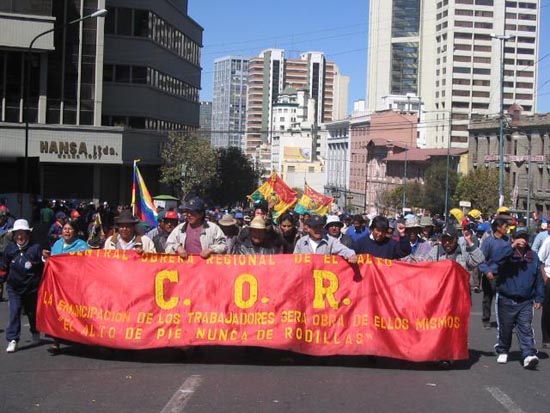
Contingent
of the combative Regional Workers Center (COR) of El Alto march on May
31.
(Photo: Indymedia/Bolivia)
The
current protests were detonated on May 5, when the Bolivian Congress
passed a
new hydrocarbons (gas and oil) law guaranteeing imperialist energy
conglomerates’ profits. This was the last straw for workers and the
poor in El
Alto, La Paz and other centers where, 19 months earlier, streets ran
red with
their blood in protests against Goni’s sweetheart contracts with the
energy
conglomerates. Fearing mass outrage, Mesa did not sign the new law
himself,
leaving that piece of dirty work to the head of Congress, Hormando Vaca
Díez, a
senator from Santa Cruz who leads a bloc of rightist parties intimately
associated with the deposed Goni.
After
Vaca Díez signed the law on May 17, the expected explosion of
mass discontent
was immediate. Congress fled the capital and Mesa left in what one
paper called
“an operation quite similar to an escape” (Página
12 [Buenos Aires], 25 May). In March, Mesa said he was resigning in
protest
against the “crazy” demands of labor and peasant groups, only to
retract his
resignation and vow to stay in office until 2007. The weakness of this
improvised president has led some bourgeois sectors to ask that early
elections
be called to replace him, while others look towards the army for
salvation.
The
turmoil in Bolivia is generated by two main forces. One is the
increasing
militancy of workers and peasants demanding that the country’s huge gas
and oil
reserves benefit the mass of the population. The other is the
“autonomist” push
by bourgeois forces in the gas-producing eastern and southern regions
to grab
more of the fabulous wealth and keep out the Indian masses of the
highlands
whom these ultra-rightists disdain with undisguised racism. Santa Cruz
was the
base of the military dictators who ruled Bolivia for a decade after
1971.
Living
in poverty for generations, millions of Bolivians feel history has
cheated them
out of the wealth generated by the resources this country has depended
on since
the Spanish Conquest: the silver mines of colonial times that made
Potosí a
synonym for riches; the tin the British and American empires required,
notably for
armaments and canned food during World Wars I and II. Now the vast
reserves of
natural gas are exported for the benefit of “multinational”
(imperialist)
companies – Enron, Shell, British Petroleum, Repsol and others – while
Bolivia
remains the second poorest country of the Americas. Even much of the
middle
class fumes over the centuries of looting of Bolivia.
Behind the
militancy is the feeling that
Carlos Mesa deceived the population with false promises of reform after
taking
over from Goni in October 2003. In July 2004 he held a referendum using
tricky
language to legitimize the gas companies’ super-profits as well as
Mesa’s own
unelected government. He has loyally served the imperialist
corporations and
the American embassy, even getting the Bolivian Senate to approve
immunity for
U.S. troops. Mesa gave in to “autonomy” demands from right-wing
entrepreneurs
in Bolivia’s richest regions, scheduling elections for departmental
governors
in August. Now he is visiting the Army barracks seeking support for a
crackdown
on the rebellious workers, peasants and Indians.
A
key role in propping up Mesa has been played by Evo Morales, leader of
largely
Quechua coca-growing peasants of the Cochabamba region and head of the
Movimiento al Socialismo (MAS–Movements Towards Socialism). Morales has
been
lionized on the left internationally and demonized by right-wing
spokesmen, but
at each crucial juncture his reformist MAS has provided crucial support
to
Mesa. Morales put a phony “anti-imperialist” spin on Mesa’s gas
referendum;
today he plays with words to claim that gas is “already” nationalized
through
royalties and taxes. There are also the envoys sent to La Paz
by the
popular-front government of Lula in Brazil and Peronist Argentine
president
Kirchner, acting as firemen for Yankee imperialism to put out the
flames of
revolution in the region.
As
the MAS tries desperately to curtail the militancy of mass protests,
Morales is
increasingly discredited and has taken to saying “the rank and file
have
outflanked us.” Yet when Carlos Mesa was installed, he received open
support or
an explicit “truce” from the entire
range of labor, slum and peasant leaders – from Morales’ rival in the
peasant
movement Felipe Quispe to Jaime Solares of the COB labor federation and
Roberto
de la Cruz of the El Alto COR union group. Many leftists hailed
“victory”
against Goni. But as we wrote at the time, “toppling the hated
president and
replacing him with his anointed successor [Mesa] is hardly a victory.”
The LFI
denounced “the betrayal by the
misleaders of the workers and peasants – including those who claim to
be
revolutionaries – in granting a ‘truce’ to the new president.” We
pointed out:
– “Bolivian Workers Uprising Knifed, Workers Still on Battle Footing,” The Internationalist No. 17, October-November 2003
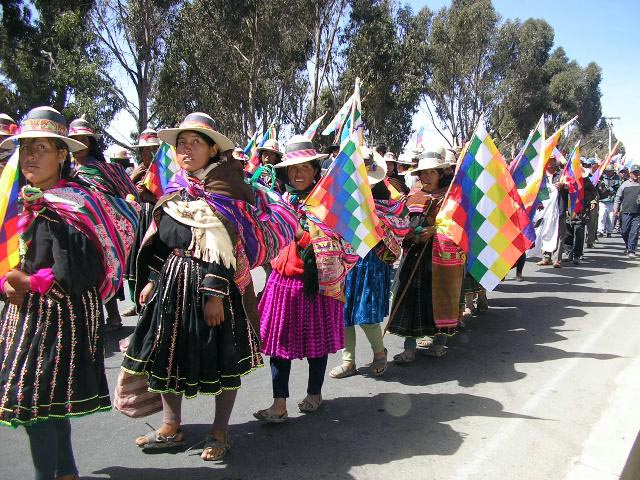
Peasamt women carrying the the multi-color wiphala flag of the indigenous movement arriving in La
Paz May 23 after marching from Caracollo to protest energy law. (Photo: Indymedia/Bolivia)
The second motor force of current turmoil comes from the right, with demands for regional “autonomy” raised by the “Civic Committee “of Santa Cruz de la Sierra department in eastern Bolivia, bordering Brazil, and Tarija department bordering Argentina in the south. The Santa Cruz capitalists and landowners are taking a page from slaveholders in the U.S. South by threatening to secede if their demands for even more wealth and power are not satisfied. The more Mesa gives in to them, the more they demand. After the president acceded to their agitation for election of a new governor, they used this to call their own “autonomy” referendum.
While
the Santa Cruz elite sometimes couches its demands in democratic
phrases, they
are openly racist: as one of Bolivia’s “whitest” regions, they want
“autonomy”
from the protests launched by Indian miners and peasants of Bolivia’s
western altiplano
(high plateau). In this
sense, their “autonomy” demands are the very opposite of calls for
autonomy by
oppressed peoples like the Indians of Chiapas, Mexico. What the cruceña bourgeoisie wants is a bigger
slice of the dollar profits from gas and oil production centered in
this
region.
Prominent
in Santa Cruz mobilizations have been the Camisas Negras (black
shirts), shock
troops of a fascistic organization calling itself “Nación Camba”
(Santa Cruz
Nation). Today, armed thugs of the UJC,
the youth group of the Civic Committee, attacked a march of some 500
peasants,
brutally injuring several women, who were demanding nationalization of
hydrocarbons and a constituent assembly. Threats and blackmail from
Santa Cruz
capitalists have been met with indignation by workers and peasants in
the rest
of Bolivia. The “autonomy” demands have also brought condemnation from
members
of the bourgeoisie’s own armed forces, who see them as inimical to
“territorial
integrity.”
Meanwhile,
the regional bourgeoisie faces conflict in its own backyard. Yesterday,
demonstrators in the capital of the department of Tarija took over
congressional delegates’ offices in solidarity with protests on the altiplano. Last month in Santa Cruz,
soldiers and police evicted eighty
families, members of Bolivia’s Landless Peasant Movement (MST), from an
hacienda in the Los Yuquises region. Representatives of the
Guaraní and other
indigenous peoples of Bolivia’s east denounce discrimination by the
local
authorities, stating that if Santa Cruz and other eastern regions get
autonomy,
they want to separate from them.
For
his part, Evo Morales of the MAS is pleading for “consensus” between
the
“agenda” of the La Paz protests and the “agenda” of the Santa Cruz
bourgeoisie.
The mechanism is supposed to be a constituent assembly. The MAS has
long called
for such a body to rewrite the Bolivian constitution, hoping to get a
bigger
slice of power. The promise to call a
constituent assembly was one of the crucial means by which Mesa worked
to
defuse the October 2003 uprising. This is hardly a revolutionary demand
in
Bolivia, which has had at least a dozen constituent assemblies since
independence. The idea that Bolivia’s bitter class struggles
over wealth and power can be resolved through this
supposedly democratic mechanism is a reformist utopia of class peace.
It
is no wonder that the constituent assembly plan is approved by the
World Bank!
This is not a case of popular masses rising up against a dictatorship
or monarchy, or entire sectors excluded from formal parliamentary
democracy, in which calls for a constituent assembly can be
appropriate. What is starkly posed in Bolivia today is workers
revolution or capitalist counterrevolution. The eastern bourgeoisie
seeks to turn its region into a Bolivian version of the reactionary
Vendée which opposed the French Revolution of 1789. They must be
decisively defeated, not conciliated. In Bolivia today, the call
for a constituent
assembly is a counterrevolutionary trap, which must be opposed by
the struggle for a successful workers revolution.
What
is urgent today is to form workers
councils (like the soviets of the Russian Revolutions of 1905 and
1917).
Such councils can draw in the urban and rural poor, indigenous peoples,
youth
and oppressed women, and rank and file soldiers unwilling to carry out
the
murderous orders of the bourgeois officer corps. With social agitation
at a
fever pitch, workers, peasants and
soldiers councils can and should be formed now as a
concrete step to take the struggle forward from the current
stalemate. While the pieces of
dynamite used in demonstrations make a loud noise, they are no
substitute for
the arming of the working class: workers
and peasants militias are crucial to defend the Bolivian working
people
today.
To rip the gas and oil resources out of the
capitalists’ claws, rather than looking to the
parliamentary politicians or a bourgeois nationalization, the working
class “should seize the oil, mining and gas facilities, imposing their
expropriation without compensation and workers control by the ranks of
production and distribution,” as we wrote in 2003.
The
only way out is a workers, peasants and
Indian government based on this proletarian democracy
of workers councils. “Obreros
al poder!” in Bolivia can be transformed from a slogan to a reality
only as
part of the fight for an Andean federation of workers republics,
a
socialist revolution that extends to the workers of the imperialist
centers as
well.
Coup Talk from Right
and
“Left”
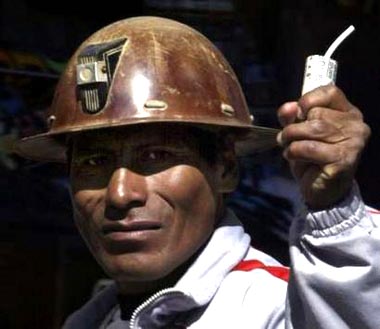 Miner
from Caracoles tin mine with dynamite during May 19 protest against
energy law. (Photo:
David Mercado/Reuters)
Miner
from Caracoles tin mine with dynamite during May 19 protest against
energy law. (Photo:
David Mercado/Reuters)Coup
rumors multiply by the hour, centering on the figure of rightist Santa
Cruz
senator Hormando Vaca Díez, who according to the constitution
would be next in
line to succeed Mesa if the president stepped down (just as Mesa put on
Goni’s
tricolor presidential sash when his former boss fled for Miami). Yet
this is
only one variant in the many scenarios for a possible coup
d’état in a country
that had so many military takeovers it was often called “Golpilandia”
(Coup-Land). For almost two decades liberals have spread the illusion
that such
coups are a thing of the past, but the purpose of the capitalist armed
forces
is precisely to use organized violence in defense of the power and
wealth of
the ruling class. It is not for nothing that in Bolivia, the symbol of
the
Military Police is a ravenous bulldog menacingly baring its teeth.
Yet
fatal illusions in capitalist officers and police are spread by leaders
of
workers, peasant and “left” organizations. Evo Morales of the MAS
demagogically
calls for army and police to occupy the oil and gas fields. Jaime
Solares of
the COB has repeatedly called for an “alliance” with “patriotic”
military
officers and support for “an honest military officer like Hugo
Chávez” of
Venezuela. In speeches against last year’s referendum, Solares
grotesquely
boasted of contacts with generals who wanted a tougher line against the
“threat” from Chile (which won Bolivia’s seacoast 125 years ago in the
War of
the Pacific).
Suicidal
illusions in “patriotic military officers” have been put forward as
well by the
Miners Federation leadership, which explicitly hailed two army
colonels, Julio
Herrera and Julio César Galindo, who made a pronunciamiento
on May 26 proclaiming a “Generational Movement” and offering to lead a
civic-military junta in which “we young officers would take charge of
this
country’s government.” Support for a military man on horseback to “save
the
nation” is an old path in Latin America, covered with corpses of the
workers
and oppressed. Most recently in Ecuador, former colonel Lucio
Gutiérrez used
populist demagogy to rope in labor, peasants and the left, only to turn
against
them in the service of Washington and the International Monetary Fund,
as the
League for the Fourth International warned he would do.
COB
officials have also harked back to the 1970-71 Bolivian regime of
General Juan
José Torres – when the left and labor movement formed a “Popular
Assembly”
whose illusions in Torres’ military populism paved the way for the
bloody
rightist coup of Hugo Banzer. This policy of class collaboration
crystallized
in the “Anti-Imperialist Revolutionary Front” (FRA) formed in exile by
Torres,
other officers, and almost all the Bolivian left, most prominently the
main
organization falsely describing itself as Trotskyist, the Partido
Obrero
Revolucionario (POR – Revolutionary Workers Party) of Guillermo Lora.
Today,
POR spokesmen in the leadership of the La Paz teachers union warn
against a
military coup while criticizing illusions in a constituent assembly
preached by
most of the reformist left. Yet the POR has remained deeply committed
to the
strategy of the FRA, even saying this front “could include the entire
police,
as an institution” and demanding “Bolivianization of the armed forces.”
A
smaller centrist organization that calls itself Trotskyist is the Liga
Obrera
Revolucionaria–Cuarta Internacional (LOR-CI – Revolutionary Workers
League-Fourth
International), affiliated to the Fracción Trotskista led by the
Argentine PTS.
The LOR-CI has spread its own illusions in the possibility of the
police
“committing themselves to the defense of the workers and the people” (Lucha Obrera, 24 February 2003).* Its trademark, however,
has been to add the adjective “Revolutionary” to Evo
Morales’ demand for a Constituent Assembly.
Constituent
assembly fetishism follows the tradition of Nahuel Moreno, the
Argentine
pseudo-Trotskyist from whom the PTS/LOR-CI tendency is derived. In the
1980s,
Moreno called for “democratic revolution” in Latin America and for “new
February revolutions,” referring to the February 1917 overthrow of the
tsar.
Genuine Trotskyists fight for new October Revolutions.
In
the recent period the LOR-CI has given increasing emphasis to the call
for a
Popular (or People’s) Assembly. The word popular
is chosen in order to emphasize that such bodies will not be
working-class in character. This is why the Stalinists called their
strategy of
class collaboration the Popular or People’s Front, why Salvador Allende
called
his alliance with bourgeois politicians and “constitutionalist”
officers (including a certain General Augusto Pinochet) the
Unidad Popular, and why reformists the world over, preparing new
defeats, chant
“The people united will never be defeated.”
 Demonstrators descend from El Alto
Demonstrators descend from El Alto to La Paz, May 30. Banner reads:
“Expel the Multinationals, Revolution Now!”
(Photo: Indymedia/Bolivia)
The
key lesson of the 1971 Popular Assembly is precisely that it tied the
workers
to Torres, doing nothing to prepare
them against the Banzer coup. On the programmatic level this sellout
was
prepared by the so-called “socialist theses” passed by the COB in 1970,
which
in a deal between the Stalinists, the POR and others, mixed leftist
phrases
with calls for “an anti-imperialist popular front.” Yet today, the
LOR-CI calls
for a program “based on the best contributions of historical COB
documents like
the Theses of Pulacayo and the Socialist Theses of 1970” (LOR-CI
declaration,
21 January).
More
than any other country in Latin America, Bolivia’s political language
has been
influenced by what is widely considered “Trotskyism,” going back to the
Theses
of Pulacayo written by the POR and approved by the miners union in
1946. This
is both a product of, and a factor contributing to, the enormous
combativity
shown by generations of Bolivian workers. Yet at each crucial juncture,
those laying
claim to Trotskyism subordinated themselves to nationalist bourgeois
politicians and military men. That is the opposite of the real content
of
Trotsky’s program of permanent revolution, which addresses just
such
situations as that of Bolivia today.
As
Trotsky concluded from the experience of revolutions in Russia and
China, the
fundamental problems of a semi-colonial country like Bolivia can be
addressed
only through a revolution in which the working class seizes state
power,
supported by the peasantry and the urban poor. Only socialist
revolution can
break the stranglehold of imperialism, resolve the land question
(including
expropriation of landed estates in Santa Cruz, untouched by the
agrarian reform
of Bolivia’s 1952 National Revolution), and win real democratic
rights for
the oppressed, first and foremost Bolivia’s indigenous majority. As
Trotsky
stressed, this permanent revolution must open the road to genuine
socialism – a
classless society of abundance – through its extension to the
industrially
advanced centers of world capitalism.
The
key is to build an authentically communist workers party to head the
struggle.
Neither populist military officers nor a “constituent,” “revolutionary
constituent” or “popular” assembly, but the revolutionary class
power of workers soviets and militias is what is required to
lead the masses of working people, peasants and all the oppressed to
victory
over the dangerous enemies confronting them today. This means a
political
struggle against the current leaders, who seek ever new ways to promote
the old
bourgeois nationalism, playing on the country’s relative geographic
isolation
and remoteness.
The workers of Bolivia are not alone. This new upsurge occurs in the context of
increasing
turmoil in Latin America. In Ecuador, the military populist Lucio
Gutiérrez is
the latest of a series of presidents driven from power in recent years.
In
Brazil, class collaboration has shown its bankruptcy anew as Lula’s
popular
front faces bitter disaffection from the working class. Peru has been
shaken by
a series of local rebellions. Labor strikes and political crises have
wracked
Mexico. In the United States, where workers face the repressive “home
front” of
the imperialist war on Iraq, a dynamic and growing sector of the
working class,
immigrant workers, forms a “human bridge” to upheavals in Latin
America. Only an internationalist perspective,
for extending revolution throughout the Americas and world-wide, can
confront
the danger of imperialist intervention faced by any genuine revolution.
International
socialist revolution was the program of Lenin’s Bolsheviks, who led the
Russian
workers to power under the slogan “All
power to the soviets!” and, with the Red Army led by Leon Trotsky,
defeated
the armed intervention of more than a dozen capitalist powers. This program was carried forward by Trotsky’s Fourth
International, which we fight to reforge.
Leaving
La Paz in October 2003, Bolivia’s miners vowed, Volveremos
– We will return – saying, “If you need to overthrow
someone again, let us know.” The facile analysts who wrote off their
power were
proven wrong yet again. Now the miners have returned, and they mean
business.
It is high time to build the revolutionary leadership, the genuine
Bolshevik
Trotskyist party, crucial to their victory at the head of the heroic
workers
and peasants of Bolivia. n
* In response to our criticisms of its line on the February 2003 police mutiny in Bolivia, the LOR-CI accused us of falsifying their position (in Revista de los Andes, Fall 2004). After being shown quotations from their paper, LOR-CI cadres conceded that our criticism was not only accurate but politically correct. To our knowledge, however, they have yet to publish the correction they vowed to print on this matter.
To contact the Internationalist Group and the League for the Fourth International, send e-mail to: internationalistgroup@msn.com